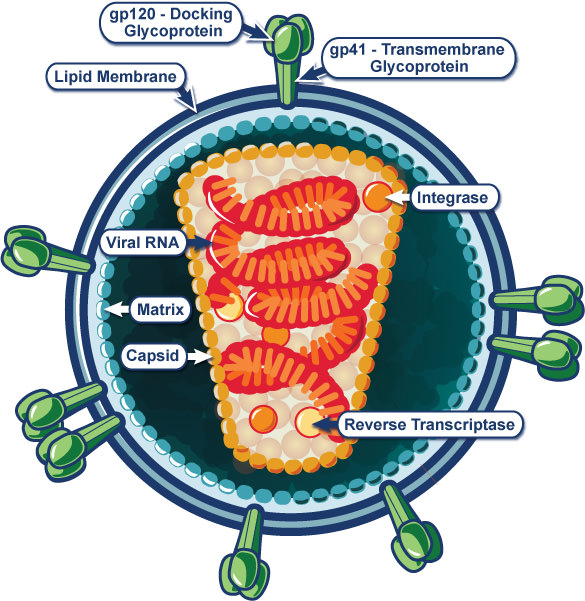7.15艾滋病毒
章节大纲
-
Why is the shape of the virus important?
::为什么病毒的形状很重要?The AIDS . One of the most devastating viruses known. Why? Notice the intricate anatomy of the virus, both inside and outside. It is the constant changing of those outside markers that make producing a vaccine against this virus difficult.
::艾滋病是已知的最具破坏性的病毒之一。为什么?注意到病毒在内部和外部的复杂解剖。正是这些外部标志的不断变化使得生产抗病毒疫苗难上加难。HIV
::艾滋病毒/艾滋病毒The Human Immunodeficiency Virus ( HIV ) is the virus that causes Acquired Immunodeficiency Syndrome ( AIDS ). Most researchers believe that the HIV originated in sub-Saharan Africa during the 20th century. HIV is transmitted by sexual contact and by contact with infected bodily fluids, such as , semen , breast milk, and vaginal secretions. It is also passed from mother to fetus . HIV is now a pandemic , with an estimated (as of 2008) 38.6 million people now living with the disease worldwide. It is estimated that AIDS has killed more than 25 million people since it was first recognized in 1981.
::人体免疫机能丧失病毒(艾滋病毒)是导致后天免疫机能丧失综合症(艾滋病)的病毒,大多数研究人员认为艾滋病毒起源于20世纪的撒哈拉以南非洲,艾滋病毒是通过性接触和接触感染的体液(如精液、母乳和阴道分泌)传播的,艾滋病毒也从母亲传染给胎儿,艾滋病毒现在是一种流行病,估计(截至2008年)全世界有3 860万人感染了这一疾病,据估计,艾滋病自1981年首次确认以来已造成2 500多万人死亡。HIV is the retrovirus that destroys the immune system . HIV primarily infects helper T cells (specifically CD4 + T cells), macrophages, and dendritic . HIV infection leads to low levels of CD4 + T cells because the virus directly kills infected cells and the infected T cells are also attacked by the immune system. The infection of a CD4 cell is shown in the Figure . When CD4 + T cell numbers decline below a certain critical level, cell-mediated is lost, and the body becomes more prone to opportunistic infections. HIV infections will be discussed further in the immune system concepts.
::艾滋病毒是摧毁免疫系统的逆向病毒。艾滋病毒主要感染帮助T细胞(特别是CD4+T细胞)、巨型动物和登地体。艾滋病毒感染导致CD4+T细胞的低水平。由于病毒直接杀死受感染的细胞和受感染T细胞也受到免疫系统的攻击,艾滋病毒感染导致CD4+T细胞的低水平。CD4+T细胞的感染在图中显示。当CD4+T细胞数量下降到某一临界水平以下时,细胞中介就消失了,身体更容易受到机会性感染。在免疫系统概念中将进一步讨论艾滋病毒感染问题。If left untreated, most HIV-infected individuals will develop AIDS. AIDS is a collection of symptoms and infections resulting from the damage to the immune system by HIV. Because the immune systems of people with AIDS are so weak, and viruses that do not normally cause disease in healthy people can easily cause disease in an AIDS patient. Opportunistic infections associated with AIDS include:
::艾滋病是艾滋病毒对免疫系统造成破坏的症状和感染的集合体,因为艾滋病患者的免疫系统非常薄弱,通常不会在健康的人中引起疾病的病毒很容易在艾滋病病人中引起疾病。-
Pneumocystis pneumonia
: a form of
pneumonia
caused by a
.
::肺炎细胞肺炎:一种由肺炎引起的肺炎。 -
Tuberculosis
(TB), caused by the
Mycobacterium tuberculosis
bacteria.
::肺结核(TB),由菌肺结核细菌引起的。 -
Lung
infections caused by Mycobacterium other than tuberculosis (MOTT).
::肺部感染由除肺结核以外的微菌引起的肺部感染(MOTT)。 -
Kaposi's sarcoma
: a type of
that is caused by Kaposi's sarcoma-associated herpesvirus (KSHV).
::Kaposi的sarcoma:这是由Kaposi的 sarcoma 与有关病毒(KSHV)引起的。
Lifecycle of HIV. The image at bottom right is an SEM of HIV budding from cultured lymphocyte. The many round bumps on the cell surface are sites of assembly and budding of virions.
::艾滋病毒的生命周期. 右下角的图象是艾滋病毒从培养的淋巴细胞开始发芽的图象,细胞表面的许多圆柱岩是病毒组装和发芽的地点。An HIV Infection
::艾滋病毒感染An HIV infection of a CD4 cell can be summarized as follows:
::CD4细胞的艾滋病毒感染可归纳如下:-
First, the viral particle attaches to the CD4 receptor and other associated receptors on the
. The
viral envelope
then fuses with the cell membrane, and the viral
capsid
moves into the cell.
::首先,病毒粒子附着在CD4受体和其他相关受体上。病毒信封随后与细胞膜引信,病毒盖子进入细胞。 -
Once the viral capsid enters the cell,
reverse transcriptase
frees the single-stranded
from the viral
and copies it into a complementary strand of
. This process of reverse
is error-prone and it is during this step that
may occur. Such mutations may cause
drug
resistance.
::一旦病毒盖子进入细胞,反转转录入酶将单串病毒从病毒中释放出来,并复制成一个互补的链条。这个反转过程容易出错,而正是在这个步骤期间可能发生。这种突变可能会引起抗药性。 -
The reverse transcriptase then makes a complementary DNA strand to form a double-stranded viral DNA (vDNA).
::然后,反转转录解脱氧核糖核酸则形成一种互补的DNA链,形成一种双层病毒DNA(VDNA)。 -
The vDNA is then moved into the cell
. The integration of the viral DNA into the
host
cell's
genome
is carried out by another viral
called
integrase
. This integrated viral DNA may then lie dormant, during the latent stage of the HIV infection. Clinical
latency
for HIV can vary between two weeks and 20 years.
::病毒DNA与宿主细胞基因组的结合由另一个叫做Integrase的病毒进行,这种综合病毒DNA在艾滋病毒感染潜伏阶段可能处于休眠状态。 -
To actively produce viruses, certain cellular
need to be present. These transcription factors are plentiful in activated T cells. This means that those cells most likely to be killed by HIV are those currently fighting infection. The virus DNA is transcribed to mRNA which then leads to new virus protein and genome production.
::为了积极生产病毒,必须存在某些细胞。这些转录系数在活性T细胞中非常丰富。这意味着那些最有可能被艾滋病毒杀死的细胞是那些目前抗感染的细胞。病毒DNA被转录到 mRNA,从而导致新的病毒蛋白和基因组生产。 -
Viral particles are assembled inside the cell and then exit the cell by
budding
. The virus gets its viral envelope from the cell’s plasma membrane. The cycle begins again when the new particles infect another cell.
::病毒从细胞的等离子膜获得病毒的病毒信封。 当新粒子感染另一个细胞时,循环会再次开始。
HIV infection is treated with a cocktail of several antiretroviral drugs . The antiretroviral drugs prevent the virus from replicating and destroying more T cells, thus preventing the patients from developing AIDS. Treatment with antiretroviral drugs can dramatically increase the life expectancy of people with HIV.
::抗逆转录病毒药物防止病毒复制和摧毁更多的T细胞,从而阻止病人发展艾滋病。 抗逆转录病毒药物的治疗可以大幅提高艾滋病毒感染者的预期寿命。Summary
::摘要-
HIV is the virus that causes AIDS. HIV destroys the immune system.
::艾滋病毒是造成艾滋病的病毒,艾滋病毒摧毁免疫系统。 -
Opportunistic infections lead to AIDS.
::机会性感染导致艾滋病。
Review
::回顾1. Describe the relationship between HIV and AIDS.
::1. 说明艾滋病毒和艾滋病之间的关系。The graph below shows the relationship between the number of HIV particles and CD4 lymphocyte counts over the course of an untreated HIV infection. Use the graph to answer the following questions:
::下图显示了艾滋病毒颗粒数和未经治疗的艾滋病毒感染过程中CD4淋巴细胞数之间的关系。2. How does the increase of the number of HIV particles relate to the path of the disease?
::2. 艾滋病毒粒子数量的增加与疾病的路径有何关联?3. Outline what happens to the number of viruses and numbers of lymphocytes between three and six weeks after initial infection.
::3. 概述最初感染后三至六周内病毒数量和淋巴细胞数量。4. Can the development of AIDS symptoms be delayed? Explain your answer.
::4. 能否推迟艾滋病症状的发展?解释你的答复。 -
Pneumocystis pneumonia
: a form of
pneumonia
caused by a
.


